BAT Operations: Continuous Improvement and Project Life Cycle Review
VerifiedAdded on 2023/06/18
|21
|7168
|470
Report
AI Summary
This report provides a comprehensive analysis of operations management principles within British American Tobacco (BAT). It reviews and critiques the implementation of these principles, focusing on Six Sigma methodology and lean principles. The report includes a continuous improvement plan based on the review, analyzing its effectiveness using relevant theories and models. Furthermore, it applies each stage of the project life cycle (PLC) to a given project, providing necessary supporting documentation. The effectiveness of the PLC is reviewed and critiqued using appropriate theories and models, differentiating between large and small-scale projects. The report concludes with an evaluation of the PLC's effectiveness, drawing conclusions and recommendations for improvements, highlighting the importance of managed passion, embracing change, and adhering to fundamental principles for operational success.

Assessment
Paraphrase This Document
Need a fresh take? Get an instant paraphrase of this document with our AI Paraphraser
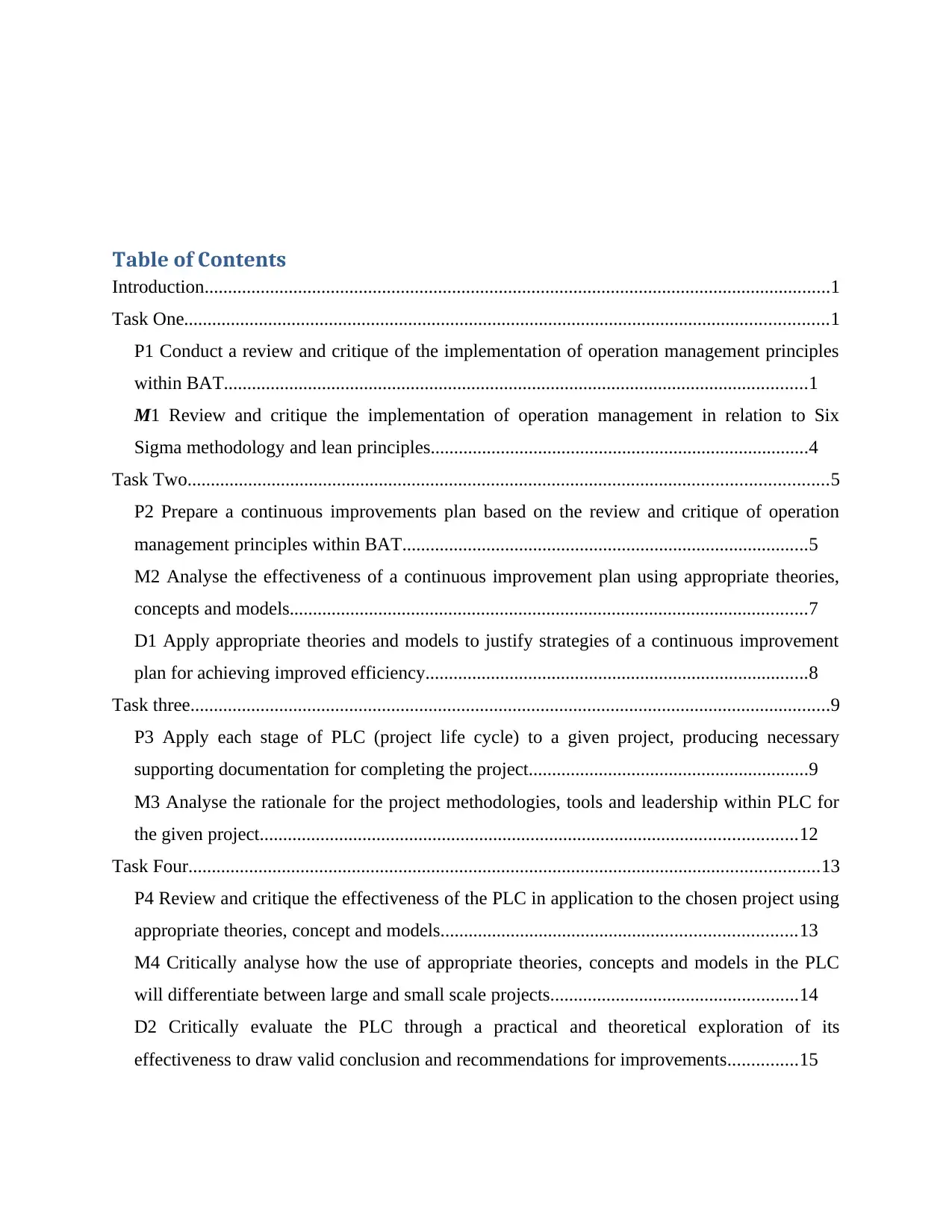
Table of Contents
Introduction......................................................................................................................................1
Task One..........................................................................................................................................1
P1 Conduct a review and critique of the implementation of operation management principles
within BAT.............................................................................................................................1
M1 Review and critique the implementation of operation management in relation to Six
Sigma methodology and lean principles.................................................................................4
Task Two.........................................................................................................................................5
P2 Prepare a continuous improvements plan based on the review and critique of operation
management principles within BAT.......................................................................................5
M2 Analyse the effectiveness of a continuous improvement plan using appropriate theories,
concepts and models...............................................................................................................7
D1 Apply appropriate theories and models to justify strategies of a continuous improvement
plan for achieving improved efficiency..................................................................................8
Task three.........................................................................................................................................9
P3 Apply each stage of PLC (project life cycle) to a given project, producing necessary
supporting documentation for completing the project............................................................9
M3 Analyse the rationale for the project methodologies, tools and leadership within PLC for
the given project...................................................................................................................12
Task Four.......................................................................................................................................13
P4 Review and critique the effectiveness of the PLC in application to the chosen project using
appropriate theories, concept and models............................................................................13
M4 Critically analyse how the use of appropriate theories, concepts and models in the PLC
will differentiate between large and small scale projects.....................................................14
D2 Critically evaluate the PLC through a practical and theoretical exploration of its
effectiveness to draw valid conclusion and recommendations for improvements...............15
Introduction......................................................................................................................................1
Task One..........................................................................................................................................1
P1 Conduct a review and critique of the implementation of operation management principles
within BAT.............................................................................................................................1
M1 Review and critique the implementation of operation management in relation to Six
Sigma methodology and lean principles.................................................................................4
Task Two.........................................................................................................................................5
P2 Prepare a continuous improvements plan based on the review and critique of operation
management principles within BAT.......................................................................................5
M2 Analyse the effectiveness of a continuous improvement plan using appropriate theories,
concepts and models...............................................................................................................7
D1 Apply appropriate theories and models to justify strategies of a continuous improvement
plan for achieving improved efficiency..................................................................................8
Task three.........................................................................................................................................9
P3 Apply each stage of PLC (project life cycle) to a given project, producing necessary
supporting documentation for completing the project............................................................9
M3 Analyse the rationale for the project methodologies, tools and leadership within PLC for
the given project...................................................................................................................12
Task Four.......................................................................................................................................13
P4 Review and critique the effectiveness of the PLC in application to the chosen project using
appropriate theories, concept and models............................................................................13
M4 Critically analyse how the use of appropriate theories, concepts and models in the PLC
will differentiate between large and small scale projects.....................................................14
D2 Critically evaluate the PLC through a practical and theoretical exploration of its
effectiveness to draw valid conclusion and recommendations for improvements...............15

Conclusion.....................................................................................................................................16
References:.....................................................................................................................................17
Books and Journals...............................................................................................................17
References:.....................................................................................................................................17
Books and Journals...............................................................................................................17
⊘ This is a preview!⊘
Do you want full access?
Subscribe today to unlock all pages.

Trusted by 1+ million students worldwide

Introduction
Operation management is the significant area of management within the business firms which is
concerned with administration of business practices with the aim of creating the highest level of
efficiency within an organisation. Operation management is primarily directed towards the
overseeing, designing and controlling the process of production along with re-designing the
operational activities of production for goods and services (Kamil, 2020). Prime purpose of
operation management is to ensure that operations of business are efficient through converting
raw materials, labour and resources into finished goods using as minimal as needed and effective
in meeting customer needs and wants while maximising the profit for the company. It is
primarily concerned with planning, organising and supervising the entire production or services
system which overlooks the activities of converting material, labour consumers and energy into
finished outputs. British American Tobacco plc (BAT) is one of the two leading tobacco
companies in UK, which manufactures and sells tobacco, cigarettes and other nicotine products.
It was founded in the year 1902 with a joint venture with American Tobacco Company,
headquartered at London, England, United Kingdom. BAT has its operations in more than 180
countries and is largest tobacco company in terms of sales across globe. The further mentioned
report covers the effectiveness of operations management principles, concept of continuous
improvement plan in BAT, application of project life cycle and application of PLC within
specified project (Holubcik and et. al., 2020).
Task One
P1 Conduct a review and critique of the implementation of operation management principles
within BAT
British American Tobacco is one of the largest tobacco manufacturer and seller in the
world dealing in tobacco, cigarettes and other nicotine products across more than 180 countries.
The Company was founded way back in 1902 with a joint venture of Imperial tobacco company
and US based American tobacco company, from there came out the name of BAT, selling wide
range of brands such as Dunhill, Kent, Lucky, Strike, Pall Mall, Rothmans, Vype and Vuse; and
Glu.
Operation management of BAT is concerned with designing, overseeing and controlling the
production process and redesigning the business operations with the aim of studying the use of
1
Operation management is the significant area of management within the business firms which is
concerned with administration of business practices with the aim of creating the highest level of
efficiency within an organisation. Operation management is primarily directed towards the
overseeing, designing and controlling the process of production along with re-designing the
operational activities of production for goods and services (Kamil, 2020). Prime purpose of
operation management is to ensure that operations of business are efficient through converting
raw materials, labour and resources into finished goods using as minimal as needed and effective
in meeting customer needs and wants while maximising the profit for the company. It is
primarily concerned with planning, organising and supervising the entire production or services
system which overlooks the activities of converting material, labour consumers and energy into
finished outputs. British American Tobacco plc (BAT) is one of the two leading tobacco
companies in UK, which manufactures and sells tobacco, cigarettes and other nicotine products.
It was founded in the year 1902 with a joint venture with American Tobacco Company,
headquartered at London, England, United Kingdom. BAT has its operations in more than 180
countries and is largest tobacco company in terms of sales across globe. The further mentioned
report covers the effectiveness of operations management principles, concept of continuous
improvement plan in BAT, application of project life cycle and application of PLC within
specified project (Holubcik and et. al., 2020).
Task One
P1 Conduct a review and critique of the implementation of operation management principles
within BAT
British American Tobacco is one of the largest tobacco manufacturer and seller in the
world dealing in tobacco, cigarettes and other nicotine products across more than 180 countries.
The Company was founded way back in 1902 with a joint venture of Imperial tobacco company
and US based American tobacco company, from there came out the name of BAT, selling wide
range of brands such as Dunhill, Kent, Lucky, Strike, Pall Mall, Rothmans, Vype and Vuse; and
Glu.
Operation management of BAT is concerned with designing, overseeing and controlling the
production process and redesigning the business operations with the aim of studying the use of
1
Paraphrase This Document
Need a fresh take? Get an instant paraphrase of this document with our AI Paraphraser
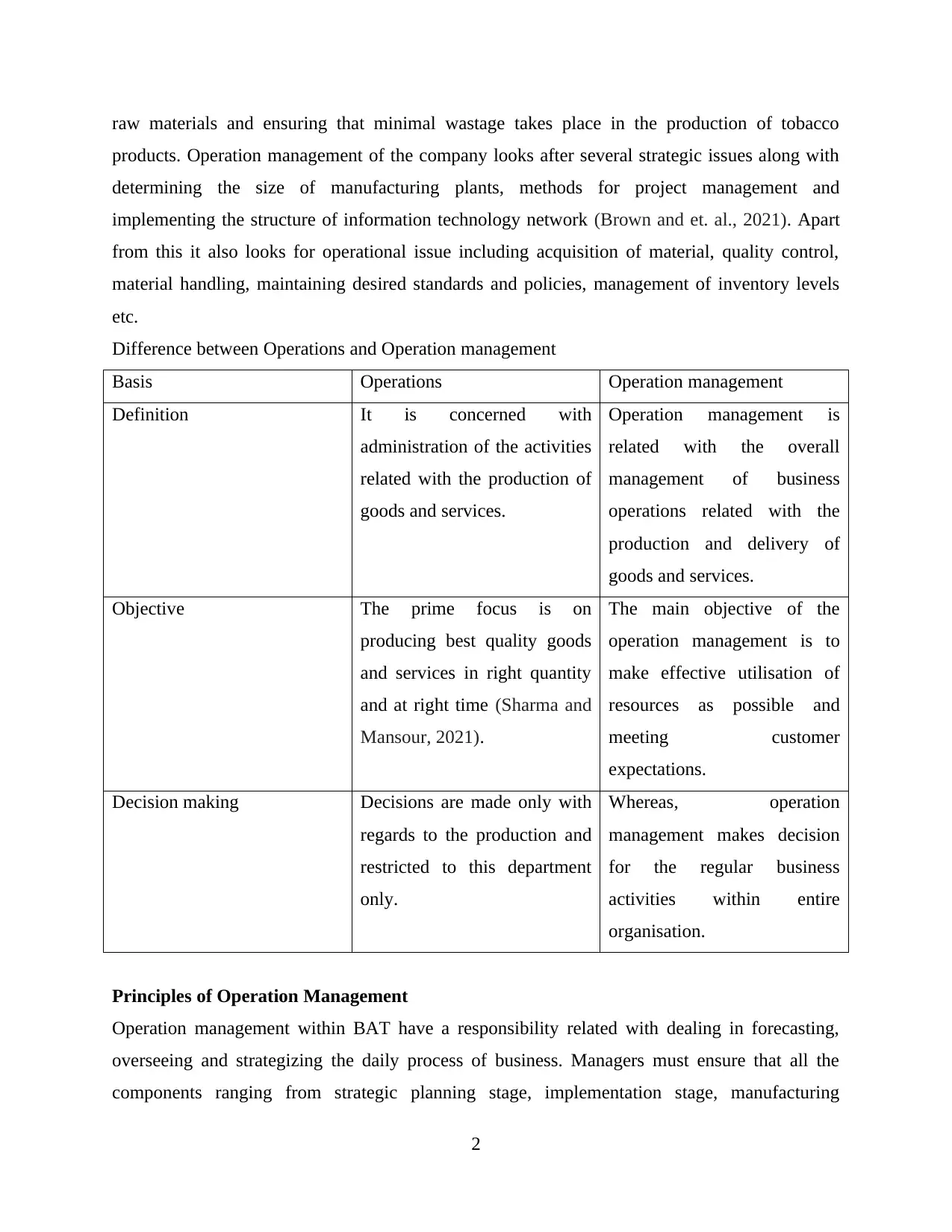
raw materials and ensuring that minimal wastage takes place in the production of tobacco
products. Operation management of the company looks after several strategic issues along with
determining the size of manufacturing plants, methods for project management and
implementing the structure of information technology network (Brown and et. al., 2021). Apart
from this it also looks for operational issue including acquisition of material, quality control,
material handling, maintaining desired standards and policies, management of inventory levels
etc.
Difference between Operations and Operation management
Basis Operations Operation management
Definition It is concerned with
administration of the activities
related with the production of
goods and services.
Operation management is
related with the overall
management of business
operations related with the
production and delivery of
goods and services.
Objective The prime focus is on
producing best quality goods
and services in right quantity
and at right time (Sharma and
Mansour, 2021).
The main objective of the
operation management is to
make effective utilisation of
resources as possible and
meeting customer
expectations.
Decision making Decisions are made only with
regards to the production and
restricted to this department
only.
Whereas, operation
management makes decision
for the regular business
activities within entire
organisation.
Principles of Operation Management
Operation management within BAT have a responsibility related with dealing in forecasting,
overseeing and strategizing the daily process of business. Managers must ensure that all the
components ranging from strategic planning stage, implementation stage, manufacturing
2
products. Operation management of the company looks after several strategic issues along with
determining the size of manufacturing plants, methods for project management and
implementing the structure of information technology network (Brown and et. al., 2021). Apart
from this it also looks for operational issue including acquisition of material, quality control,
material handling, maintaining desired standards and policies, management of inventory levels
etc.
Difference between Operations and Operation management
Basis Operations Operation management
Definition It is concerned with
administration of the activities
related with the production of
goods and services.
Operation management is
related with the overall
management of business
operations related with the
production and delivery of
goods and services.
Objective The prime focus is on
producing best quality goods
and services in right quantity
and at right time (Sharma and
Mansour, 2021).
The main objective of the
operation management is to
make effective utilisation of
resources as possible and
meeting customer
expectations.
Decision making Decisions are made only with
regards to the production and
restricted to this department
only.
Whereas, operation
management makes decision
for the regular business
activities within entire
organisation.
Principles of Operation Management
Operation management within BAT have a responsibility related with dealing in forecasting,
overseeing and strategizing the daily process of business. Managers must ensure that all the
components ranging from strategic planning stage, implementation stage, manufacturing
2
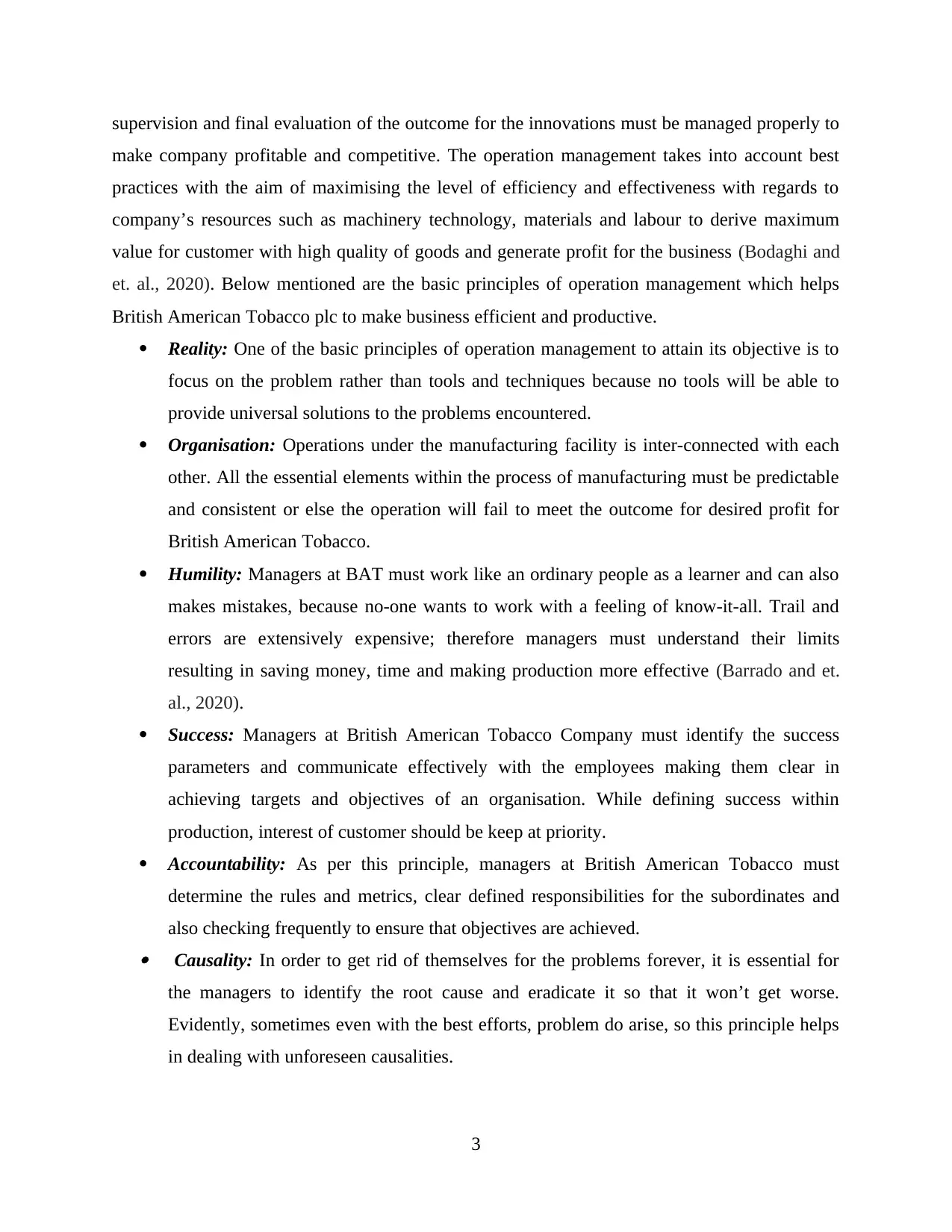
supervision and final evaluation of the outcome for the innovations must be managed properly to
make company profitable and competitive. The operation management takes into account best
practices with the aim of maximising the level of efficiency and effectiveness with regards to
company’s resources such as machinery technology, materials and labour to derive maximum
value for customer with high quality of goods and generate profit for the business (Bodaghi and
et. al., 2020). Below mentioned are the basic principles of operation management which helps
British American Tobacco plc to make business efficient and productive.
Reality: One of the basic principles of operation management to attain its objective is to
focus on the problem rather than tools and techniques because no tools will be able to
provide universal solutions to the problems encountered.
Organisation: Operations under the manufacturing facility is inter-connected with each
other. All the essential elements within the process of manufacturing must be predictable
and consistent or else the operation will fail to meet the outcome for desired profit for
British American Tobacco.
Humility: Managers at BAT must work like an ordinary people as a learner and can also
makes mistakes, because no-one wants to work with a feeling of know-it-all. Trail and
errors are extensively expensive; therefore managers must understand their limits
resulting in saving money, time and making production more effective (Barrado and et.
al., 2020).
Success: Managers at British American Tobacco Company must identify the success
parameters and communicate effectively with the employees making them clear in
achieving targets and objectives of an organisation. While defining success within
production, interest of customer should be keep at priority.
Accountability: As per this principle, managers at British American Tobacco must
determine the rules and metrics, clear defined responsibilities for the subordinates and
also checking frequently to ensure that objectives are achieved. Causality: In order to get rid of themselves for the problems forever, it is essential for
the managers to identify the root cause and eradicate it so that it won’t get worse.
Evidently, sometimes even with the best efforts, problem do arise, so this principle helps
in dealing with unforeseen causalities.
3
make company profitable and competitive. The operation management takes into account best
practices with the aim of maximising the level of efficiency and effectiveness with regards to
company’s resources such as machinery technology, materials and labour to derive maximum
value for customer with high quality of goods and generate profit for the business (Bodaghi and
et. al., 2020). Below mentioned are the basic principles of operation management which helps
British American Tobacco plc to make business efficient and productive.
Reality: One of the basic principles of operation management to attain its objective is to
focus on the problem rather than tools and techniques because no tools will be able to
provide universal solutions to the problems encountered.
Organisation: Operations under the manufacturing facility is inter-connected with each
other. All the essential elements within the process of manufacturing must be predictable
and consistent or else the operation will fail to meet the outcome for desired profit for
British American Tobacco.
Humility: Managers at BAT must work like an ordinary people as a learner and can also
makes mistakes, because no-one wants to work with a feeling of know-it-all. Trail and
errors are extensively expensive; therefore managers must understand their limits
resulting in saving money, time and making production more effective (Barrado and et.
al., 2020).
Success: Managers at British American Tobacco Company must identify the success
parameters and communicate effectively with the employees making them clear in
achieving targets and objectives of an organisation. While defining success within
production, interest of customer should be keep at priority.
Accountability: As per this principle, managers at British American Tobacco must
determine the rules and metrics, clear defined responsibilities for the subordinates and
also checking frequently to ensure that objectives are achieved. Causality: In order to get rid of themselves for the problems forever, it is essential for
the managers to identify the root cause and eradicate it so that it won’t get worse.
Evidently, sometimes even with the best efforts, problem do arise, so this principle helps
in dealing with unforeseen causalities.
3
⊘ This is a preview!⊘
Do you want full access?
Subscribe today to unlock all pages.

Trusted by 1+ million students worldwide
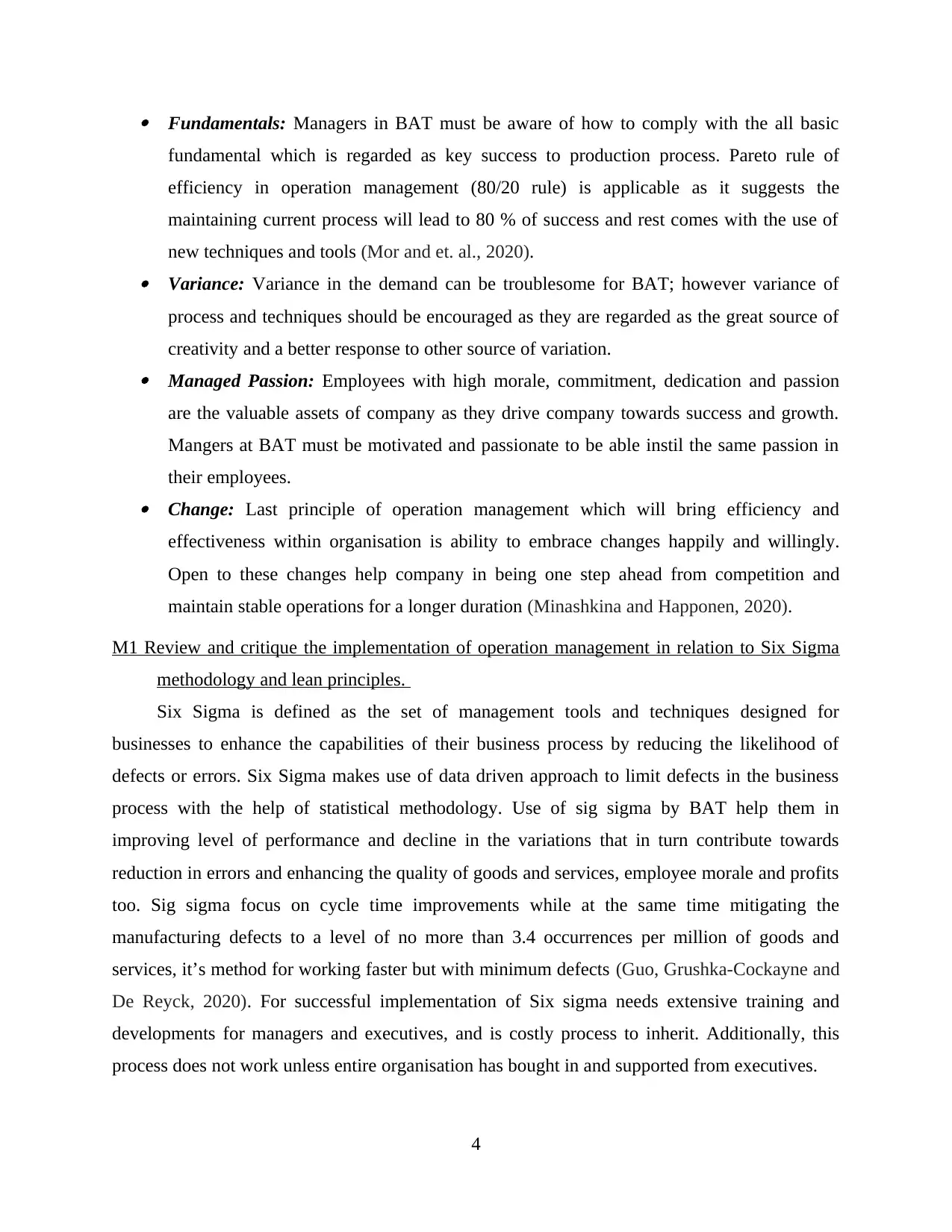
Fundamentals: Managers in BAT must be aware of how to comply with the all basic
fundamental which is regarded as key success to production process. Pareto rule of
efficiency in operation management (80/20 rule) is applicable as it suggests the
maintaining current process will lead to 80 % of success and rest comes with the use of
new techniques and tools (Mor and et. al., 2020). Variance: Variance in the demand can be troublesome for BAT; however variance of
process and techniques should be encouraged as they are regarded as the great source of
creativity and a better response to other source of variation. Managed Passion: Employees with high morale, commitment, dedication and passion
are the valuable assets of company as they drive company towards success and growth.
Mangers at BAT must be motivated and passionate to be able instil the same passion in
their employees. Change: Last principle of operation management which will bring efficiency and
effectiveness within organisation is ability to embrace changes happily and willingly.
Open to these changes help company in being one step ahead from competition and
maintain stable operations for a longer duration (Minashkina and Happonen, 2020).
M1 Review and critique the implementation of operation management in relation to Six Sigma
methodology and lean principles.
Six Sigma is defined as the set of management tools and techniques designed for
businesses to enhance the capabilities of their business process by reducing the likelihood of
defects or errors. Six Sigma makes use of data driven approach to limit defects in the business
process with the help of statistical methodology. Use of sig sigma by BAT help them in
improving level of performance and decline in the variations that in turn contribute towards
reduction in errors and enhancing the quality of goods and services, employee morale and profits
too. Sig sigma focus on cycle time improvements while at the same time mitigating the
manufacturing defects to a level of no more than 3.4 occurrences per million of goods and
services, it’s method for working faster but with minimum defects (Guo, Grushka-Cockayne and
De Reyck, 2020). For successful implementation of Six sigma needs extensive training and
developments for managers and executives, and is costly process to inherit. Additionally, this
process does not work unless entire organisation has bought in and supported from executives.
4
fundamental which is regarded as key success to production process. Pareto rule of
efficiency in operation management (80/20 rule) is applicable as it suggests the
maintaining current process will lead to 80 % of success and rest comes with the use of
new techniques and tools (Mor and et. al., 2020). Variance: Variance in the demand can be troublesome for BAT; however variance of
process and techniques should be encouraged as they are regarded as the great source of
creativity and a better response to other source of variation. Managed Passion: Employees with high morale, commitment, dedication and passion
are the valuable assets of company as they drive company towards success and growth.
Mangers at BAT must be motivated and passionate to be able instil the same passion in
their employees. Change: Last principle of operation management which will bring efficiency and
effectiveness within organisation is ability to embrace changes happily and willingly.
Open to these changes help company in being one step ahead from competition and
maintain stable operations for a longer duration (Minashkina and Happonen, 2020).
M1 Review and critique the implementation of operation management in relation to Six Sigma
methodology and lean principles.
Six Sigma is defined as the set of management tools and techniques designed for
businesses to enhance the capabilities of their business process by reducing the likelihood of
defects or errors. Six Sigma makes use of data driven approach to limit defects in the business
process with the help of statistical methodology. Use of sig sigma by BAT help them in
improving level of performance and decline in the variations that in turn contribute towards
reduction in errors and enhancing the quality of goods and services, employee morale and profits
too. Sig sigma focus on cycle time improvements while at the same time mitigating the
manufacturing defects to a level of no more than 3.4 occurrences per million of goods and
services, it’s method for working faster but with minimum defects (Guo, Grushka-Cockayne and
De Reyck, 2020). For successful implementation of Six sigma needs extensive training and
developments for managers and executives, and is costly process to inherit. Additionally, this
process does not work unless entire organisation has bought in and supported from executives.
4
Paraphrase This Document
Need a fresh take? Get an instant paraphrase of this document with our AI Paraphraser
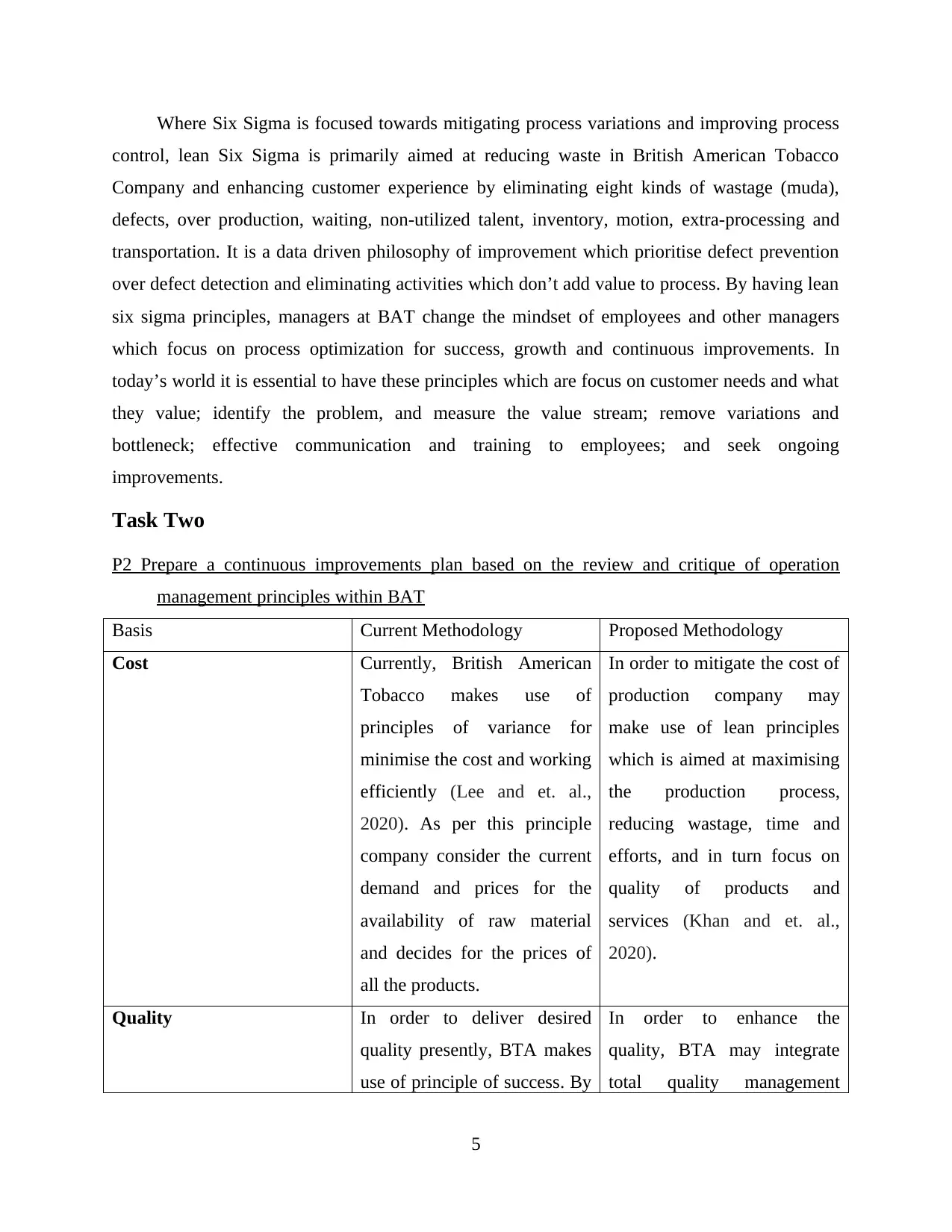
Where Six Sigma is focused towards mitigating process variations and improving process
control, lean Six Sigma is primarily aimed at reducing waste in British American Tobacco
Company and enhancing customer experience by eliminating eight kinds of wastage (muda),
defects, over production, waiting, non-utilized talent, inventory, motion, extra-processing and
transportation. It is a data driven philosophy of improvement which prioritise defect prevention
over defect detection and eliminating activities which don’t add value to process. By having lean
six sigma principles, managers at BAT change the mindset of employees and other managers
which focus on process optimization for success, growth and continuous improvements. In
today’s world it is essential to have these principles which are focus on customer needs and what
they value; identify the problem, and measure the value stream; remove variations and
bottleneck; effective communication and training to employees; and seek ongoing
improvements.
Task Two
P2 Prepare a continuous improvements plan based on the review and critique of operation
management principles within BAT
Basis Current Methodology Proposed Methodology
Cost Currently, British American
Tobacco makes use of
principles of variance for
minimise the cost and working
efficiently (Lee and et. al.,
2020). As per this principle
company consider the current
demand and prices for the
availability of raw material
and decides for the prices of
all the products.
In order to mitigate the cost of
production company may
make use of lean principles
which is aimed at maximising
the production process,
reducing wastage, time and
efforts, and in turn focus on
quality of products and
services (Khan and et. al.,
2020).
Quality In order to deliver desired
quality presently, BTA makes
use of principle of success. By
In order to enhance the
quality, BTA may integrate
total quality management
5
control, lean Six Sigma is primarily aimed at reducing waste in British American Tobacco
Company and enhancing customer experience by eliminating eight kinds of wastage (muda),
defects, over production, waiting, non-utilized talent, inventory, motion, extra-processing and
transportation. It is a data driven philosophy of improvement which prioritise defect prevention
over defect detection and eliminating activities which don’t add value to process. By having lean
six sigma principles, managers at BAT change the mindset of employees and other managers
which focus on process optimization for success, growth and continuous improvements. In
today’s world it is essential to have these principles which are focus on customer needs and what
they value; identify the problem, and measure the value stream; remove variations and
bottleneck; effective communication and training to employees; and seek ongoing
improvements.
Task Two
P2 Prepare a continuous improvements plan based on the review and critique of operation
management principles within BAT
Basis Current Methodology Proposed Methodology
Cost Currently, British American
Tobacco makes use of
principles of variance for
minimise the cost and working
efficiently (Lee and et. al.,
2020). As per this principle
company consider the current
demand and prices for the
availability of raw material
and decides for the prices of
all the products.
In order to mitigate the cost of
production company may
make use of lean principles
which is aimed at maximising
the production process,
reducing wastage, time and
efforts, and in turn focus on
quality of products and
services (Khan and et. al.,
2020).
Quality In order to deliver desired
quality presently, BTA makes
use of principle of success. By
In order to enhance the
quality, BTA may integrate
total quality management
5
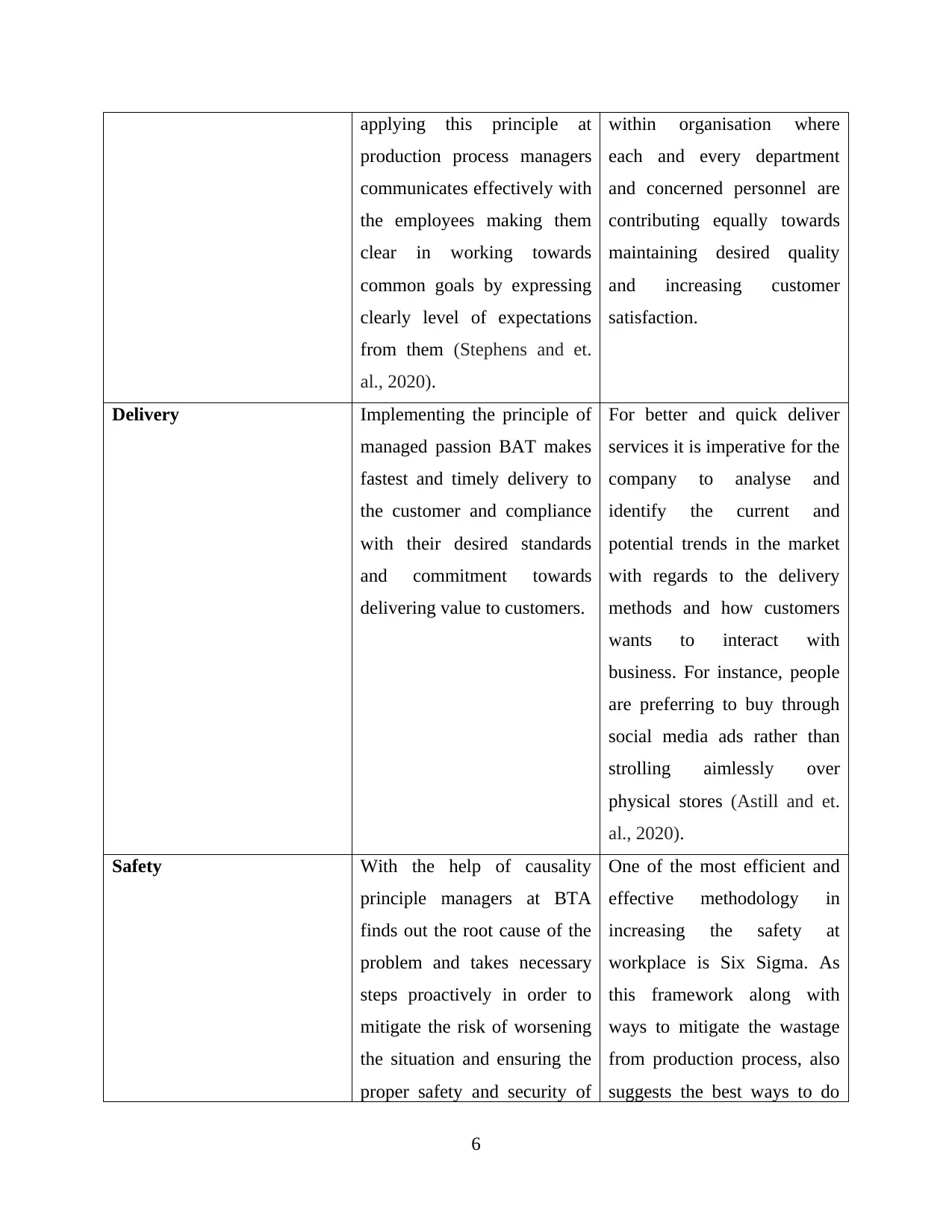
applying this principle at
production process managers
communicates effectively with
the employees making them
clear in working towards
common goals by expressing
clearly level of expectations
from them (Stephens and et.
al., 2020).
within organisation where
each and every department
and concerned personnel are
contributing equally towards
maintaining desired quality
and increasing customer
satisfaction.
Delivery Implementing the principle of
managed passion BAT makes
fastest and timely delivery to
the customer and compliance
with their desired standards
and commitment towards
delivering value to customers.
For better and quick deliver
services it is imperative for the
company to analyse and
identify the current and
potential trends in the market
with regards to the delivery
methods and how customers
wants to interact with
business. For instance, people
are preferring to buy through
social media ads rather than
strolling aimlessly over
physical stores (Astill and et.
al., 2020).
Safety With the help of causality
principle managers at BTA
finds out the root cause of the
problem and takes necessary
steps proactively in order to
mitigate the risk of worsening
the situation and ensuring the
proper safety and security of
One of the most efficient and
effective methodology in
increasing the safety at
workplace is Six Sigma. As
this framework along with
ways to mitigate the wastage
from production process, also
suggests the best ways to do
6
production process managers
communicates effectively with
the employees making them
clear in working towards
common goals by expressing
clearly level of expectations
from them (Stephens and et.
al., 2020).
within organisation where
each and every department
and concerned personnel are
contributing equally towards
maintaining desired quality
and increasing customer
satisfaction.
Delivery Implementing the principle of
managed passion BAT makes
fastest and timely delivery to
the customer and compliance
with their desired standards
and commitment towards
delivering value to customers.
For better and quick deliver
services it is imperative for the
company to analyse and
identify the current and
potential trends in the market
with regards to the delivery
methods and how customers
wants to interact with
business. For instance, people
are preferring to buy through
social media ads rather than
strolling aimlessly over
physical stores (Astill and et.
al., 2020).
Safety With the help of causality
principle managers at BTA
finds out the root cause of the
problem and takes necessary
steps proactively in order to
mitigate the risk of worsening
the situation and ensuring the
proper safety and security of
One of the most efficient and
effective methodology in
increasing the safety at
workplace is Six Sigma. As
this framework along with
ways to mitigate the wastage
from production process, also
suggests the best ways to do
6
⊘ This is a preview!⊘
Do you want full access?
Subscribe today to unlock all pages.

Trusted by 1+ million students worldwide
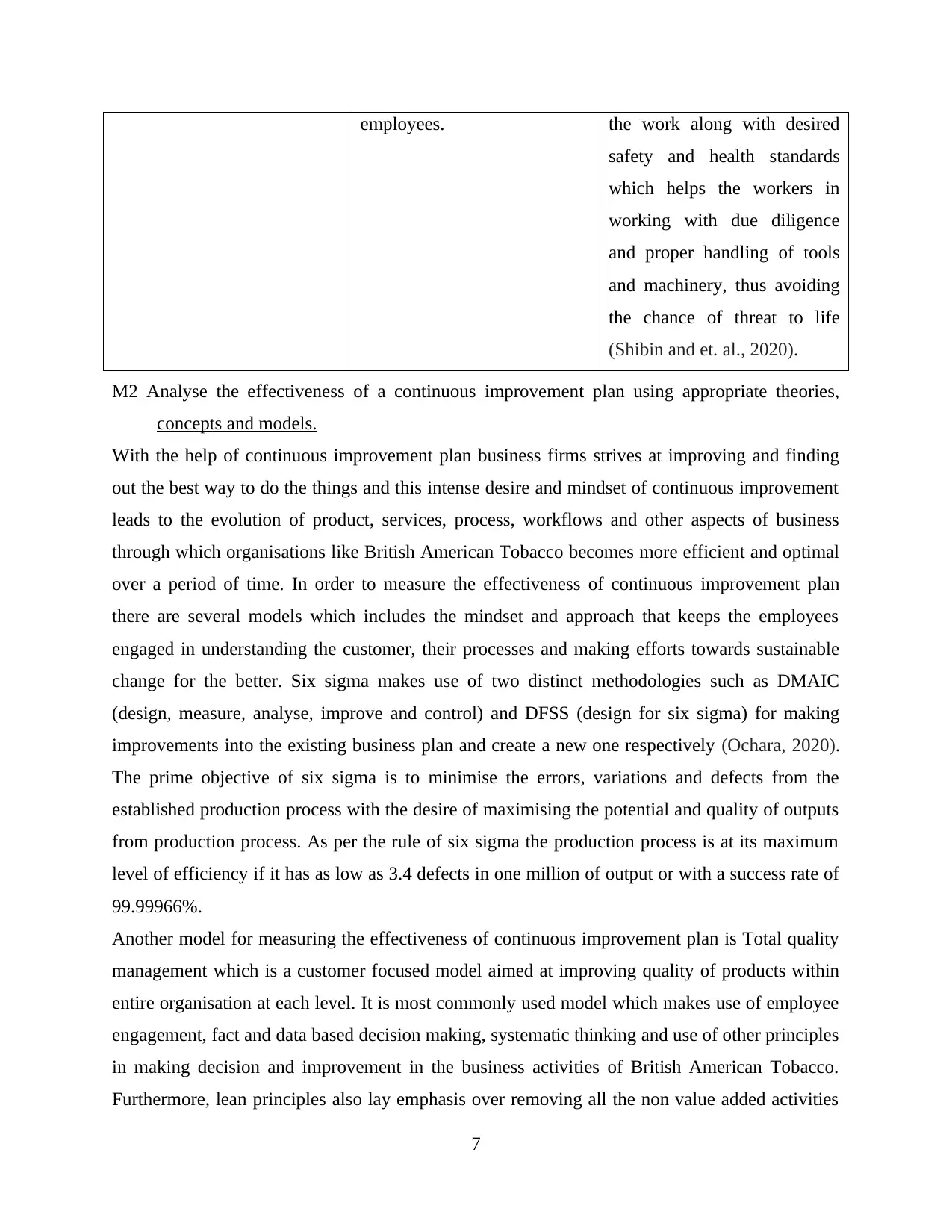
employees. the work along with desired
safety and health standards
which helps the workers in
working with due diligence
and proper handling of tools
and machinery, thus avoiding
the chance of threat to life
(Shibin and et. al., 2020).
M2 Analyse the effectiveness of a continuous improvement plan using appropriate theories,
concepts and models.
With the help of continuous improvement plan business firms strives at improving and finding
out the best way to do the things and this intense desire and mindset of continuous improvement
leads to the evolution of product, services, process, workflows and other aspects of business
through which organisations like British American Tobacco becomes more efficient and optimal
over a period of time. In order to measure the effectiveness of continuous improvement plan
there are several models which includes the mindset and approach that keeps the employees
engaged in understanding the customer, their processes and making efforts towards sustainable
change for the better. Six sigma makes use of two distinct methodologies such as DMAIC
(design, measure, analyse, improve and control) and DFSS (design for six sigma) for making
improvements into the existing business plan and create a new one respectively (Ochara, 2020).
The prime objective of six sigma is to minimise the errors, variations and defects from the
established production process with the desire of maximising the potential and quality of outputs
from production process. As per the rule of six sigma the production process is at its maximum
level of efficiency if it has as low as 3.4 defects in one million of output or with a success rate of
99.99966%.
Another model for measuring the effectiveness of continuous improvement plan is Total quality
management which is a customer focused model aimed at improving quality of products within
entire organisation at each level. It is most commonly used model which makes use of employee
engagement, fact and data based decision making, systematic thinking and use of other principles
in making decision and improvement in the business activities of British American Tobacco.
Furthermore, lean principles also lay emphasis over removing all the non value added activities
7
safety and health standards
which helps the workers in
working with due diligence
and proper handling of tools
and machinery, thus avoiding
the chance of threat to life
(Shibin and et. al., 2020).
M2 Analyse the effectiveness of a continuous improvement plan using appropriate theories,
concepts and models.
With the help of continuous improvement plan business firms strives at improving and finding
out the best way to do the things and this intense desire and mindset of continuous improvement
leads to the evolution of product, services, process, workflows and other aspects of business
through which organisations like British American Tobacco becomes more efficient and optimal
over a period of time. In order to measure the effectiveness of continuous improvement plan
there are several models which includes the mindset and approach that keeps the employees
engaged in understanding the customer, their processes and making efforts towards sustainable
change for the better. Six sigma makes use of two distinct methodologies such as DMAIC
(design, measure, analyse, improve and control) and DFSS (design for six sigma) for making
improvements into the existing business plan and create a new one respectively (Ochara, 2020).
The prime objective of six sigma is to minimise the errors, variations and defects from the
established production process with the desire of maximising the potential and quality of outputs
from production process. As per the rule of six sigma the production process is at its maximum
level of efficiency if it has as low as 3.4 defects in one million of output or with a success rate of
99.99966%.
Another model for measuring the effectiveness of continuous improvement plan is Total quality
management which is a customer focused model aimed at improving quality of products within
entire organisation at each level. It is most commonly used model which makes use of employee
engagement, fact and data based decision making, systematic thinking and use of other principles
in making decision and improvement in the business activities of British American Tobacco.
Furthermore, lean principles also lay emphasis over removing all the non value added activities
7
Paraphrase This Document
Need a fresh take? Get an instant paraphrase of this document with our AI Paraphraser
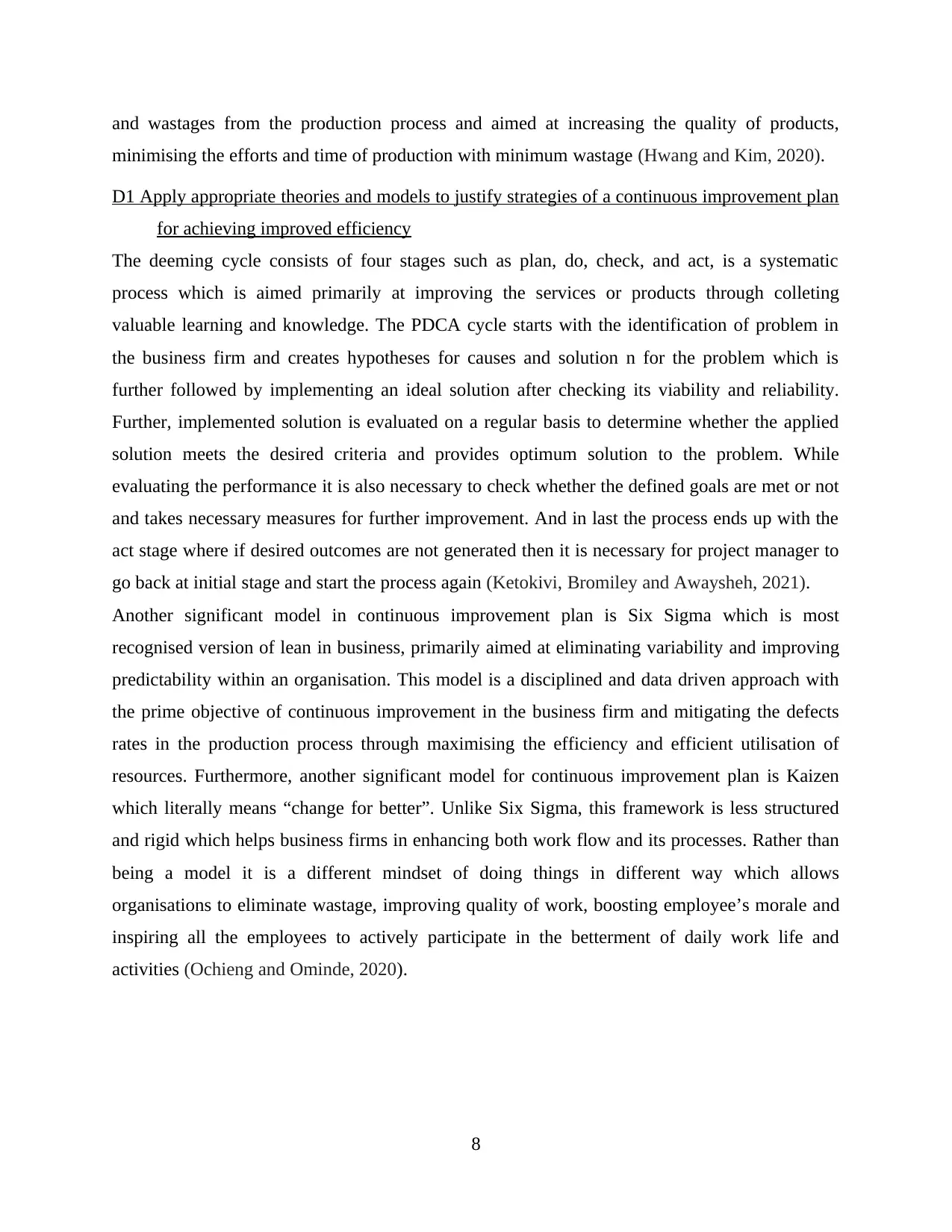
and wastages from the production process and aimed at increasing the quality of products,
minimising the efforts and time of production with minimum wastage (Hwang and Kim, 2020).
D1 Apply appropriate theories and models to justify strategies of a continuous improvement plan
for achieving improved efficiency
The deeming cycle consists of four stages such as plan, do, check, and act, is a systematic
process which is aimed primarily at improving the services or products through colleting
valuable learning and knowledge. The PDCA cycle starts with the identification of problem in
the business firm and creates hypotheses for causes and solution n for the problem which is
further followed by implementing an ideal solution after checking its viability and reliability.
Further, implemented solution is evaluated on a regular basis to determine whether the applied
solution meets the desired criteria and provides optimum solution to the problem. While
evaluating the performance it is also necessary to check whether the defined goals are met or not
and takes necessary measures for further improvement. And in last the process ends up with the
act stage where if desired outcomes are not generated then it is necessary for project manager to
go back at initial stage and start the process again (Ketokivi, Bromiley and Awaysheh, 2021).
Another significant model in continuous improvement plan is Six Sigma which is most
recognised version of lean in business, primarily aimed at eliminating variability and improving
predictability within an organisation. This model is a disciplined and data driven approach with
the prime objective of continuous improvement in the business firm and mitigating the defects
rates in the production process through maximising the efficiency and efficient utilisation of
resources. Furthermore, another significant model for continuous improvement plan is Kaizen
which literally means “change for better”. Unlike Six Sigma, this framework is less structured
and rigid which helps business firms in enhancing both work flow and its processes. Rather than
being a model it is a different mindset of doing things in different way which allows
organisations to eliminate wastage, improving quality of work, boosting employee’s morale and
inspiring all the employees to actively participate in the betterment of daily work life and
activities (Ochieng and Ominde, 2020).
8
minimising the efforts and time of production with minimum wastage (Hwang and Kim, 2020).
D1 Apply appropriate theories and models to justify strategies of a continuous improvement plan
for achieving improved efficiency
The deeming cycle consists of four stages such as plan, do, check, and act, is a systematic
process which is aimed primarily at improving the services or products through colleting
valuable learning and knowledge. The PDCA cycle starts with the identification of problem in
the business firm and creates hypotheses for causes and solution n for the problem which is
further followed by implementing an ideal solution after checking its viability and reliability.
Further, implemented solution is evaluated on a regular basis to determine whether the applied
solution meets the desired criteria and provides optimum solution to the problem. While
evaluating the performance it is also necessary to check whether the defined goals are met or not
and takes necessary measures for further improvement. And in last the process ends up with the
act stage where if desired outcomes are not generated then it is necessary for project manager to
go back at initial stage and start the process again (Ketokivi, Bromiley and Awaysheh, 2021).
Another significant model in continuous improvement plan is Six Sigma which is most
recognised version of lean in business, primarily aimed at eliminating variability and improving
predictability within an organisation. This model is a disciplined and data driven approach with
the prime objective of continuous improvement in the business firm and mitigating the defects
rates in the production process through maximising the efficiency and efficient utilisation of
resources. Furthermore, another significant model for continuous improvement plan is Kaizen
which literally means “change for better”. Unlike Six Sigma, this framework is less structured
and rigid which helps business firms in enhancing both work flow and its processes. Rather than
being a model it is a different mindset of doing things in different way which allows
organisations to eliminate wastage, improving quality of work, boosting employee’s morale and
inspiring all the employees to actively participate in the betterment of daily work life and
activities (Ochieng and Ominde, 2020).
8
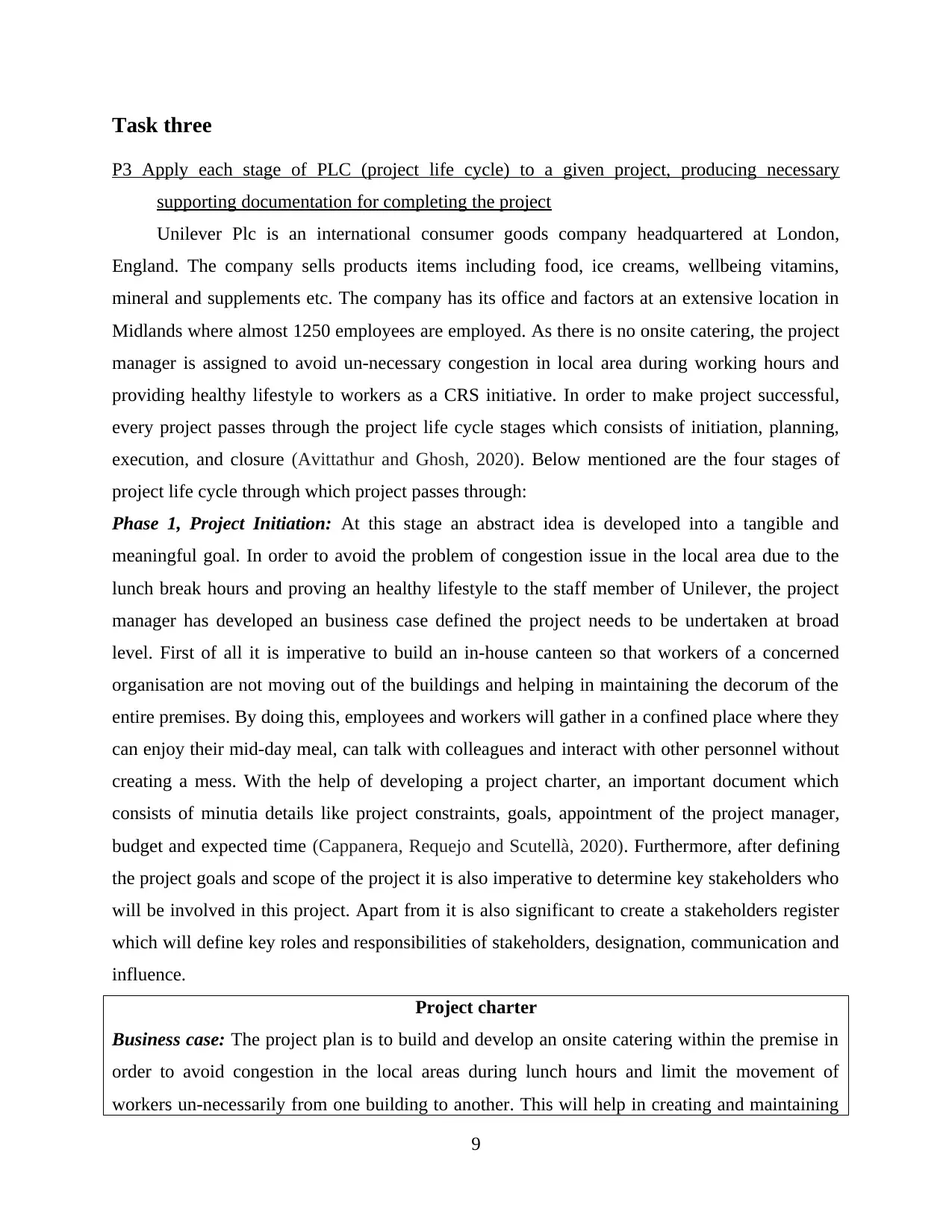
Task three
P3 Apply each stage of PLC (project life cycle) to a given project, producing necessary
supporting documentation for completing the project
Unilever Plc is an international consumer goods company headquartered at London,
England. The company sells products items including food, ice creams, wellbeing vitamins,
mineral and supplements etc. The company has its office and factors at an extensive location in
Midlands where almost 1250 employees are employed. As there is no onsite catering, the project
manager is assigned to avoid un-necessary congestion in local area during working hours and
providing healthy lifestyle to workers as a CRS initiative. In order to make project successful,
every project passes through the project life cycle stages which consists of initiation, planning,
execution, and closure (Avittathur and Ghosh, 2020). Below mentioned are the four stages of
project life cycle through which project passes through:
Phase 1, Project Initiation: At this stage an abstract idea is developed into a tangible and
meaningful goal. In order to avoid the problem of congestion issue in the local area due to the
lunch break hours and proving an healthy lifestyle to the staff member of Unilever, the project
manager has developed an business case defined the project needs to be undertaken at broad
level. First of all it is imperative to build an in-house canteen so that workers of a concerned
organisation are not moving out of the buildings and helping in maintaining the decorum of the
entire premises. By doing this, employees and workers will gather in a confined place where they
can enjoy their mid-day meal, can talk with colleagues and interact with other personnel without
creating a mess. With the help of developing a project charter, an important document which
consists of minutia details like project constraints, goals, appointment of the project manager,
budget and expected time (Cappanera, Requejo and Scutellà, 2020). Furthermore, after defining
the project goals and scope of the project it is also imperative to determine key stakeholders who
will be involved in this project. Apart from it is also significant to create a stakeholders register
which will define key roles and responsibilities of stakeholders, designation, communication and
influence.
Project charter
Business case: The project plan is to build and develop an onsite catering within the premise in
order to avoid congestion in the local areas during lunch hours and limit the movement of
workers un-necessarily from one building to another. This will help in creating and maintaining
9
P3 Apply each stage of PLC (project life cycle) to a given project, producing necessary
supporting documentation for completing the project
Unilever Plc is an international consumer goods company headquartered at London,
England. The company sells products items including food, ice creams, wellbeing vitamins,
mineral and supplements etc. The company has its office and factors at an extensive location in
Midlands where almost 1250 employees are employed. As there is no onsite catering, the project
manager is assigned to avoid un-necessary congestion in local area during working hours and
providing healthy lifestyle to workers as a CRS initiative. In order to make project successful,
every project passes through the project life cycle stages which consists of initiation, planning,
execution, and closure (Avittathur and Ghosh, 2020). Below mentioned are the four stages of
project life cycle through which project passes through:
Phase 1, Project Initiation: At this stage an abstract idea is developed into a tangible and
meaningful goal. In order to avoid the problem of congestion issue in the local area due to the
lunch break hours and proving an healthy lifestyle to the staff member of Unilever, the project
manager has developed an business case defined the project needs to be undertaken at broad
level. First of all it is imperative to build an in-house canteen so that workers of a concerned
organisation are not moving out of the buildings and helping in maintaining the decorum of the
entire premises. By doing this, employees and workers will gather in a confined place where they
can enjoy their mid-day meal, can talk with colleagues and interact with other personnel without
creating a mess. With the help of developing a project charter, an important document which
consists of minutia details like project constraints, goals, appointment of the project manager,
budget and expected time (Cappanera, Requejo and Scutellà, 2020). Furthermore, after defining
the project goals and scope of the project it is also imperative to determine key stakeholders who
will be involved in this project. Apart from it is also significant to create a stakeholders register
which will define key roles and responsibilities of stakeholders, designation, communication and
influence.
Project charter
Business case: The project plan is to build and develop an onsite catering within the premise in
order to avoid congestion in the local areas during lunch hours and limit the movement of
workers un-necessarily from one building to another. This will help in creating and maintaining
9
⊘ This is a preview!⊘
Do you want full access?
Subscribe today to unlock all pages.

Trusted by 1+ million students worldwide
1 out of 21
Related Documents
Your All-in-One AI-Powered Toolkit for Academic Success.
+13062052269
info@desklib.com
Available 24*7 on WhatsApp / Email
![[object Object]](/_next/static/media/star-bottom.7253800d.svg)
Unlock your academic potential
Copyright © 2020–2025 A2Z Services. All Rights Reserved. Developed and managed by ZUCOL.





